traction control VOLVO V60 2014 Owners Manual
[x] Cancel search | Manufacturer: VOLVO, Model Year: 2014, Model line: V60, Model: VOLVO V60 2014Pages: 442, PDF Size: 13.85 MB
Page 7 of 442
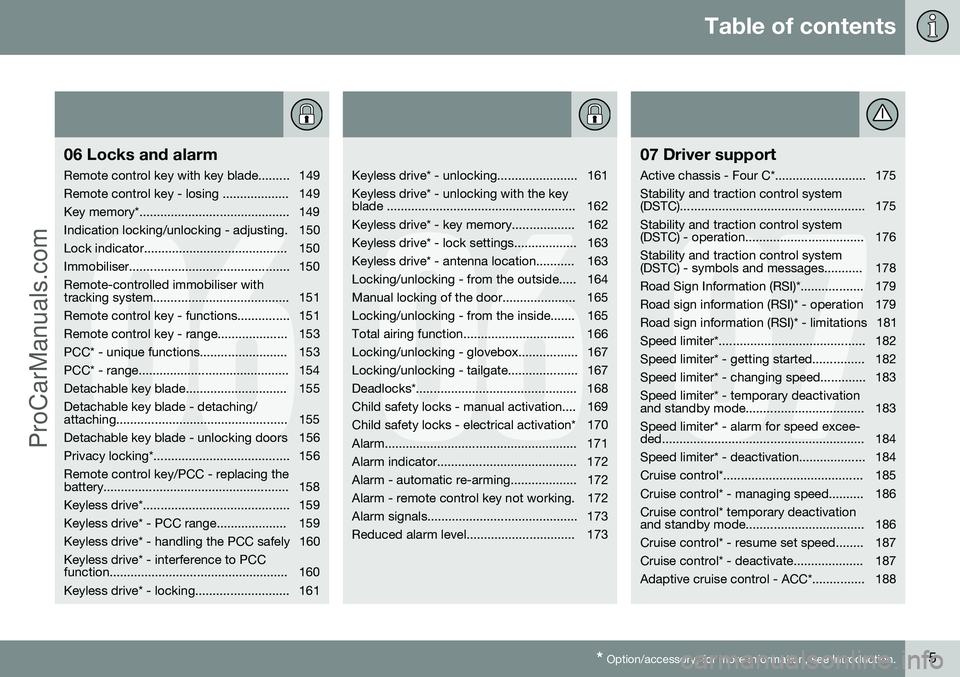
Table of contents
* Option/accessory, for more information, see Introduction.5
06
06 Locks and alarm
Remote control key with key blade......... 149
Remote control key - losing ................... 149
Key memory*........................................... 149
Indication locking/unlocking - adjusting. 150
Lock indicator......................................... 150
Immobiliser.............................................. 150Remote-controlled immobiliser with
tracking system....................................... 151
Remote control key - functions............... 151
Remote control key - range.................... 153
PCC* - unique functions......................... 153
PCC* - range........................................... 154
Detachable key blade............................. 155Detachable key blade - detaching/
attaching................................................. 155
Detachable key blade - unlocking doors 156
Privacy locking*....................................... 156Remote control key/PCC - replacing the
battery..................................................... 158
Keyless drive*.......................................... 159
Keyless drive* - PCC range.................... 159
Keyless drive* - handling the PCC safely 160Keyless drive* - interference to PCC
function................................................... 160
Keyless drive* - locking........................... 161
06
Keyless drive* - unlocking....................... 161 Keyless drive* - unlocking with the key
blade ...................................................... 162
Keyless drive* - key memory.................. 162
Keyless drive* - lock settings.................. 163
Keyless drive* - antenna location........... 163
Locking/unlocking - from the outside..... 164
Manual locking of the door..................... 165
Locking/unlocking - from the inside....... 165
Total airing function................................ 166
Locking/unlocking - glovebox................. 167
Locking/unlocking - tailgate.................... 167
Deadlocks*.............................................. 168
Child safety locks - manual activation.... 169
Child safety locks - electrical activation* 170
Alarm....................................................... 171
Alarm indicator........................................ 172
Alarm - automatic re-arming................... 172
Alarm - remote control key not working. 172
Alarm signals........................................... 173
Reduced alarm level............................... 173
07
07 Driver support
Active chassis - Four C*.......................... 175 Stability and traction control system
(DSTC)..................................................... 175 Stability and traction control system
(DSTC) - operation.................................. 176 Stability and traction control system
(DSTC) - symbols and messages........... 178
Road Sign Information (RSI)*.................. 179
Road sign information (RSI)* - operation 179
Road sign information (RSI)* - limitations 181
Speed limiter*.......................................... 182
Speed limiter* - getting started............... 182
Speed limiter* - changing speed............. 183Speed limiter* - temporary deactivation
and standby mode.................................. 183 Speed limiter* - alarm for speed excee-
ded.......................................................... 184
Speed limiter* - deactivation................... 184
Cruise control*........................................ 185
Cruise control* - managing speed.......... 186Cruise control* temporary deactivation
and standby mode.................................. 186
Cruise control* - resume set speed........ 187
Cruise control* - deactivate.................... 187
Adaptive cruise control - ACC*............... 188
ProCarManuals.co’
Page 97 of 442
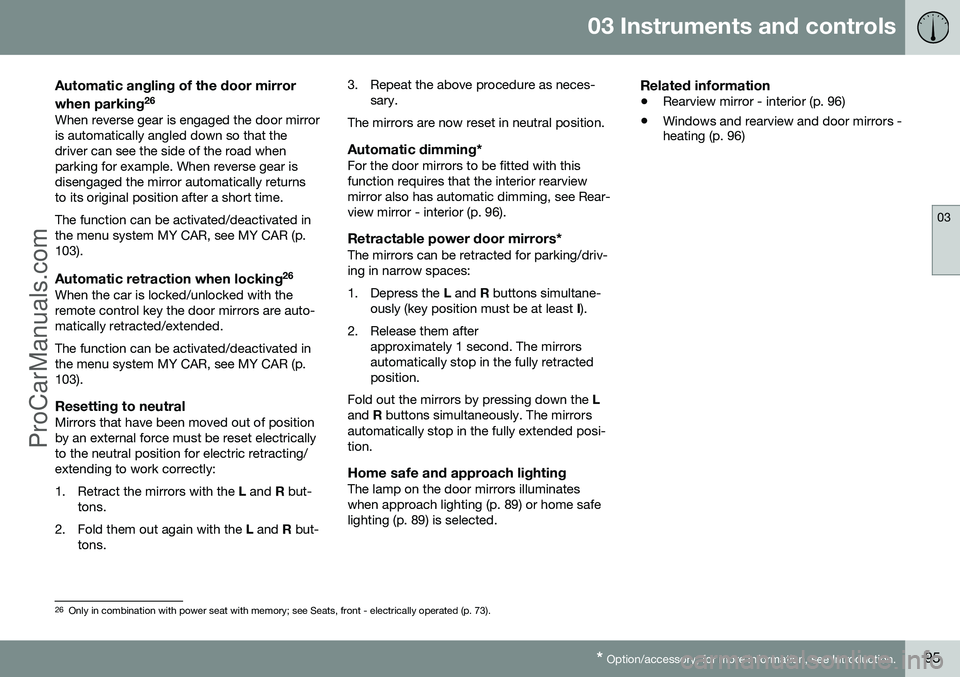
03 Instruments and controls
03
* Option/accessory, for more information, see Introduction.95
Automatic angling of the door mirror when parking 26
When reverse gear is engaged the door mirror is automatically angled down so that thedriver can see the side of the road whenparking for example. When reverse gear isdisengaged the mirror automatically returnsto its original position after a short time. The function can be activated/deactivated in the menu system MY CAR, see MY CAR (p.103).
Automatic retraction when locking 26When the car is locked/unlocked with theremote control key the door mirrors are auto-matically retracted/extended. The function can be activated/deactivated in the menu system MY CAR, see MY CAR (p.103).
Resetting to neutralMirrors that have been moved out of positionby an external force must be reset electricallyto the neutral position for electric retracting/extending to work correctly:
1. Retract the mirrors with the
L and R but-
tons.
2. Fold them out again with the L and R but-
tons. 3. Repeat the above procedure as neces-
sary.
The mirrors are now reset in neutral position.
Automatic dimming*For the door mirrors to be fitted with this function requires that the interior rearviewmirror also has automatic dimming, see Rear-view mirror - interior (p. 96).
Retractable power door mirrors*The mirrors can be retracted for parking/driv-ing in narrow spaces:
1. Depress the L and R buttons simultane-
ously (key position must be at least I).
2. Release them after approximately 1 second. The mirrors automatically stop in the fully retractedposition.
Fold out the mirrors by pressing down the L
and R buttons simultaneously. The mirrors
automatically stop in the fully extended posi-tion.
Home safe and approach lightingThe lamp on the door mirrors illuminateswhen approach lighting (p. 89) or home safelighting (p. 89) is selected.
Related information
• Rearview mirror - interior (p. 96)
• Windows and rearview and door mirrors - heating (p. 96)
26
Only in combination with power seat with memory; see Seats, front - electrically operated (p. 73).
ProCarManuals.co’
Page 177 of 442
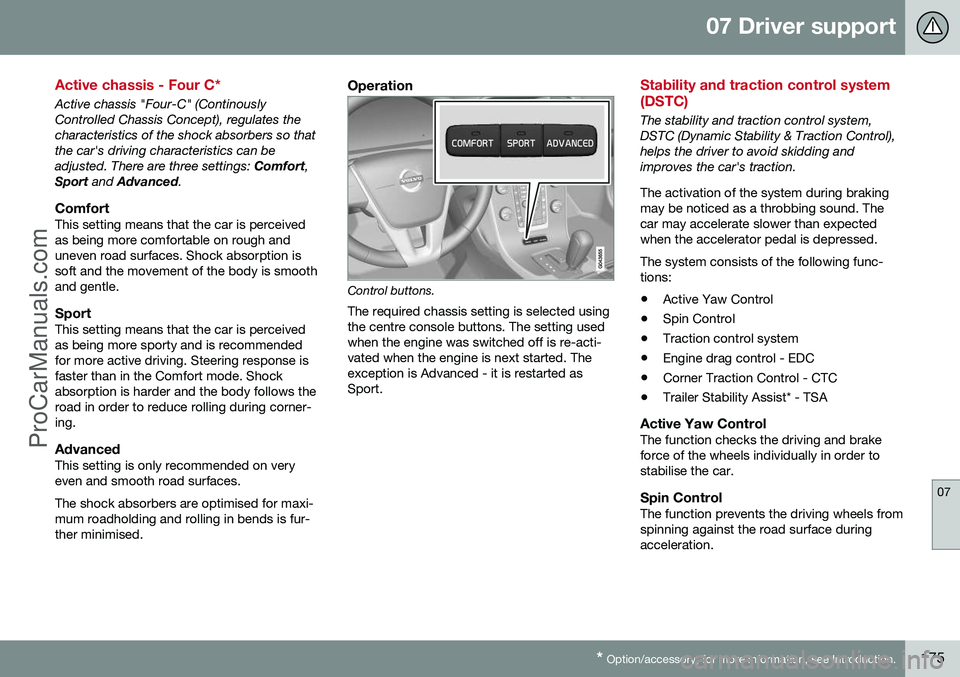
07 Driver support
07
* Option/accessory, for more information, see Introduction.175
Active chassis - Four C*
Active chassis "Four-C" (Continously Controlled Chassis Concept), regulates thecharacteristics of the shock absorbers so thatthe car's driving characteristics can beadjusted. There are three settings: Comfort,
Sport and Advanced .
ComfortThis setting means that the car is perceivedas being more comfortable on rough anduneven road surfaces. Shock absorption issoft and the movement of the body is smoothand gentle.
SportThis setting means that the car is perceivedas being more sporty and is recommendedfor more active driving. Steering response isfaster than in the Comfort mode. Shockabsorption is harder and the body follows theroad in order to reduce rolling during corner-ing.
AdvancedThis setting is only recommended on veryeven and smooth road surfaces. The shock absorbers are optimised for maxi- mum roadholding and rolling in bends is fur-ther minimised.
Operation
Control buttons.
The required chassis setting is selected using the centre console buttons. The setting usedwhen the engine was switched off is re-acti-vated when the engine is next started. Theexception is Advanced - it is restarted asSport.
Stability and traction control system (DSTC)
The stability and traction control system, DSTC (Dynamic Stability & Traction Control),helps the driver to avoid skidding andimproves the car's traction. The activation of the system during braking may be noticed as a throbbing sound. Thecar may accelerate slower than expectedwhen the accelerator pedal is depressed. The system consists of the following func- tions: • Active Yaw Control
• Spin Control
• Traction control system
• Engine drag control - EDC
• Corner Traction Control - CTC
• Trailer Stability Assist* - TSA
Active Yaw ControlThe function checks the driving and brake force of the wheels individually in order tostabilise the car.
Spin ControlThe function prevents the driving wheels fromspinning against the road surface duringacceleration.
ProCarManuals.co’
Page 178 of 442

||
07 Driver support
07
176* Option/accessory, for more information, see Introduction.
Traction control systemThe function is active at low speed and trans- fers power from the driving wheel that is spin-ning to the one that is not.
Engine drag control (EDC)EDC (Engine Drag Control) prevents involun-tary wheel locking, e.g. after shifting down orengine braking when driving in low gears onslippery road surfaces. Involuntary wheel locking while driving can, amongst other things, impair the driver's abil-ity to steer the car.
Corner Traction Control (CTC)*CTC compensates for understeer and allowshigher than normal acceleration in a bendwithout wheelspin on the inner wheel, e.g. onan arcing motorway entrance road to quicklyreach the prevailing traffic speed.
Trailer Stability Assist 1Trailer stability assist (p. 312) function is tostabilise the car and trailer combination if itbegins to snake. For more information, seeDriving with a trailer (p. 306).
NOTE
The function is deactivated if the driver selects
Sport mode.
Related information
•Stability and traction control system (DSTC) - operation (p. 176)
• Stability and traction control system(DSTC) - symbols and messages (p. 178)
Stability and traction control system (DSTC) - operation
The stability and traction control system (p. 175) (DSTC - Dynamic Stability & TractionControl), helps the driver to avoid skiddingand improves the car's traction.
Selection of level - Sport modeThe stability and traction control system isalways activated - it cannot be switched off. However, the driver can select the
Sport
mode, which allows for a more active driving experience. In Sport mode the system
detects whether the accelerator pedal, steer-ing wheel movements and cornering are moreactive than in normal driving and then allowscontrolled skidding with the rear section up toa certain level before it intervenes and stabil-ises the car. If the driver interrupts a controlled skid by releasing the accelerator pedal then the sta-bility and traction control system intervenesand stabilises the car. With Sport mode, maximum traction is
obtained if the car has become stuck, or when driving on a loose surface - e.g. sand ordeep snow. Sport mode is selected in the menu system
MY CAR. For a description of the menu sys- tem, see MY CAR (p. 103).
1 Included in the installation of Volvo genuine towbar.
ProCarManuals.co’
Page 179 of 442
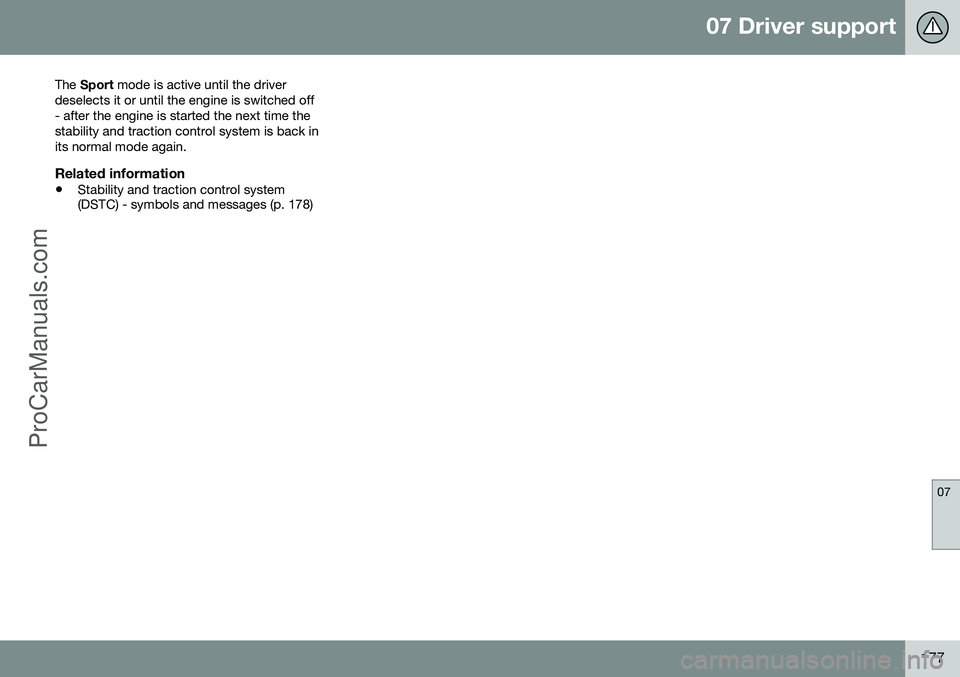
07 Driver support
07
177
The
Sport mode is active until the driver
deselects it or until the engine is switched off - after the engine is started the next time thestability and traction control system is back inits normal mode again.
Related information
• Stability and traction control system (DSTC) - symbols and messages (p. 178)
ProCarManuals.co’
Page 180 of 442

07 Driver support
07
178
Stability and traction control system (DSTC) - symbols and messages
The stability and traction control system (p. 175) (DSTC - Dynamic Stability & TractionControl) helps the driver to avoid skidding andimproves the car's traction.
Table
SymbolMessageSpecification
DSTC Temporarily OFFThe system is temporarily reduced due to excessive brake disc temperature. - The function is reactiva- ted automatically when the brakes have cooled.
DSTC Service requiredThe system is disengaged.
• Stop the car in a safe place, switch off the engine and start it again.
• Visit a workshop if the message remains - an authorised Volvo workshop is recommended.
and
"Message"There is a text message in the combined instrument panel (p. 59) - Read it!
Constant glow for 2 seconds.System check when the engine is started.
Flashing light.The system is being activated.
Sport
mode is activated.
Related information
•Stability and traction control system (DSTC) - operation (p. 176)
ProCarManuals.co’
Page 188 of 442

07 Driver support
07
186* Option/accessory, for more information, see Introduction.
Cruise control* - managing speed
The cruise control (CC – Cruise Control) helps the driver to maintain an even speed. It ispossible to activate, set or change the speed.
Activating and setting the speedTo enable cruise control:
• Press the steering wheel button
> The cruise control symbol in the com-
bined instrument panel changes from WHITE to GREY and shows that thecruise control is in standby mode.
To activate cruise control:
• At the required speed - press the steering wheel button
or .
> The current speed is stored in the mem- ory and the combined instrument panel's marking (5) is illuminated/turns WHITE atthe selected speed.
NOTE
Cruise Control cannot be enabled at speeds below 30 km/h.
Changing the speedTo change the stored speed: • Adjust with short presses on
or -
every press gives +/- 5 km/h. The last presses made are stored in the memory.
To adjust +/- 1 km/h: •
Hold down the button and release it atthe required speed.
A temporary increase in speed with the accel- erator pedal, e.g. during overtaking, does notaffect the cruise control setting - the carreturns to the set speed when the acceleratorpedal is released.
NOTE
If any of the Cruise Control buttons are held depressed for several minutes then itis blocked and deactivated. To be able toreactivate Cruise Control, the car must bestopped and the engine restarted.
Related information
• Cruise control* (p. 185)
• Cruise control* temporary deactivation and standby mode (p. 186)
• Cruise control* - resume set speed (p.187)
• Cruise control* - deactivate (p. 187)
Cruise control* temporary deactivation and standby mode
The cruise control (CC – Cruise Control) helps the driver to maintain an even speed. Thefunction can be temporarily deactivated andset in standby mode.
Temporary deactivation - standby modeTo temporarily disengage cruise control andset it in standby mode:
• Press the steering wheel button
.
> The combined instrument panel's mark- ing (5) and the symbol (6) change colour from WHITE to GREY.
Automatic standby modeCruise control is temporarily disengaged andset in standby mode if:
• wheels lose traction
• the foot brake is used
• speed falls below approx. 30 km/h
ProCarManuals.co’
Page 196 of 442
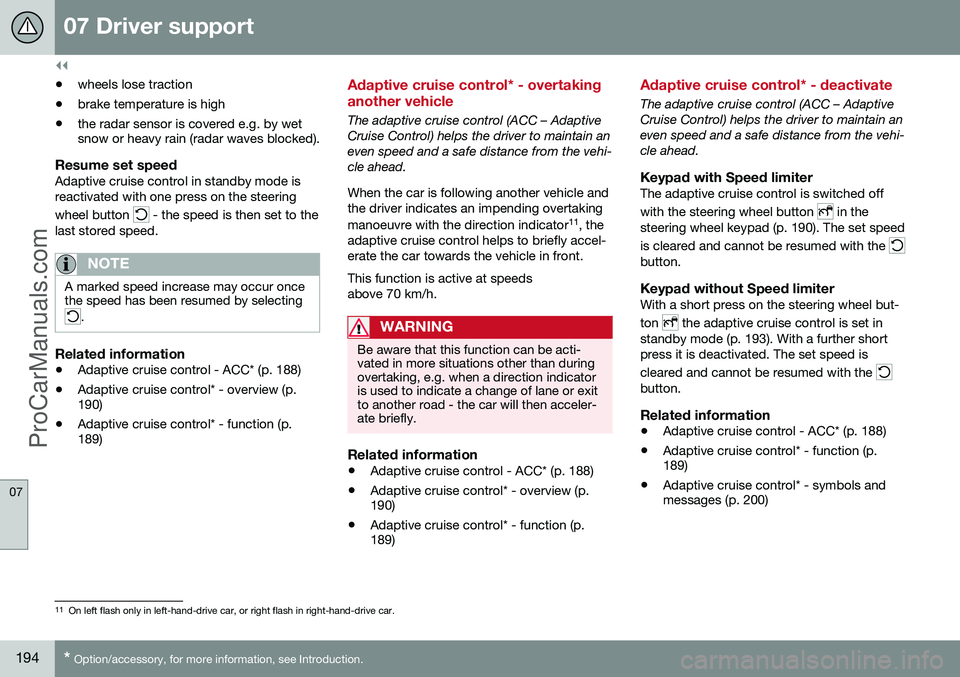
||
07 Driver support
07
194* Option/accessory, for more information, see Introduction.
• wheels lose traction
• brake temperature is high
• the radar sensor is covered e.g. by wet snow or heavy rain (radar waves blocked).
Resume set speedAdaptive cruise control in standby mode is reactivated with one press on the steering wheel button
- the speed is then set to the
last stored speed.
NOTE
A marked speed increase may occur once the speed has been resumed by selecting
.
Related information
• Adaptive cruise control - ACC* (p. 188)
• Adaptive cruise control* - overview (p. 190)
• Adaptive cruise control* - function (p.189)
Adaptive cruise control* - overtaking another vehicle
The adaptive cruise control (ACC – Adaptive Cruise Control) helps the driver to maintain aneven speed and a safe distance from the vehi-cle ahead. When the car is following another vehicle and the driver indicates an impending overtaking manoeuvre with the direction indicator 11
, the
adaptive cruise control helps to briefly accel- erate the car towards the vehicle in front. This function is active at speeds above 70 km/h.
WARNING
Be aware that this function can be acti- vated in more situations other than duringovertaking, e.g. when a direction indicatoris used to indicate a change of lane or exitto another road - the car will then acceler-ate briefly.
Related information
• Adaptive cruise control - ACC* (p. 188)
• Adaptive cruise control* - overview (p. 190)
• Adaptive cruise control* - function (p.189)
Adaptive cruise control* - deactivate
The adaptive cruise control (ACC – Adaptive Cruise Control) helps the driver to maintain aneven speed and a safe distance from the vehi-cle ahead.
Keypad with Speed limiterThe adaptive cruise control is switched off with the steering wheel button
in the
steering wheel keypad (p. 190). The set speed is cleared and cannot be resumed with the
button.
Keypad without Speed limiterWith a short press on the steering wheel but- ton
the adaptive cruise control is set in
standby mode (p. 193). With a further short press it is deactivated. The set speed is cleared and cannot be resumed with the
button.
Related information
• Adaptive cruise control - ACC* (p. 188)
• Adaptive cruise control* - function (p. 189)
• Adaptive cruise control* - symbols andmessages (p. 200)
11
On left flash only in left-hand-drive car, or right flash in right-hand-drive car.
ProCarManuals.co’
Page 202 of 442
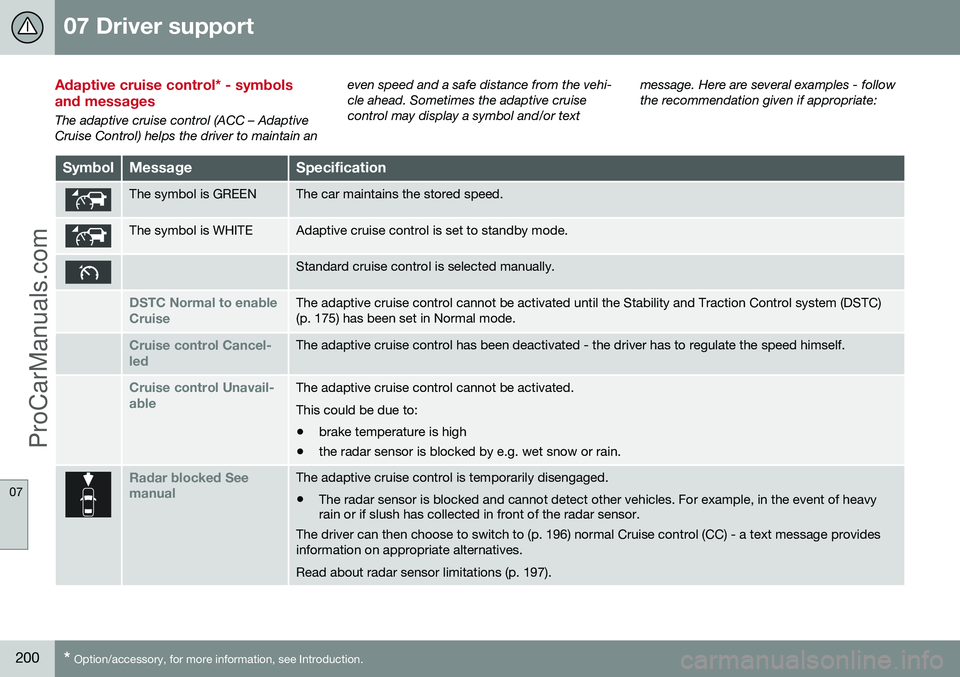
07 Driver support
07
200* Option/accessory, for more information, see Introduction.
Adaptive cruise control* - symbols and messages
The adaptive cruise control (ACC – Adaptive Cruise Control) helps the driver to maintain an even speed and a safe distance from the vehi-cle ahead. Sometimes the adaptive cruisecontrol may display a symbol and/or text
message. Here are several examples - followthe recommendation given if appropriate:
SymbolMessageSpecification
The symbol is GREENThe car maintains the stored speed.
The symbol is WHITEAdaptive cruise control is set to standby mode.
Standard cruise control is selected manually.
DSTC Normal to enable CruiseThe adaptive cruise control cannot be activated until the Stability and Traction Control system (DSTC) (p. 175) has been set in Normal mode.
Cruise control Cancel- ledThe adaptive cruise control has been deactivated - the driver has to regulate the speed himself.
Cruise control Unavail- ableThe adaptive cruise control cannot be activated. This could be due to:
• brake temperature is high
• the radar sensor is blocked by e.g. wet snow or rain.
Radar blocked See manualThe adaptive cruise control is temporarily disengaged.
• The radar sensor is blocked and cannot detect other vehicles. For example, in the event of heavy rain or if slush has collected in front of the radar sensor.
The driver can then choose to switch to (p. 196) normal Cruise control (CC) - a text message provides information on appropriate alternatives. Read about radar sensor limitations (p. 197).
ProCarManuals.co’
Page 250 of 442
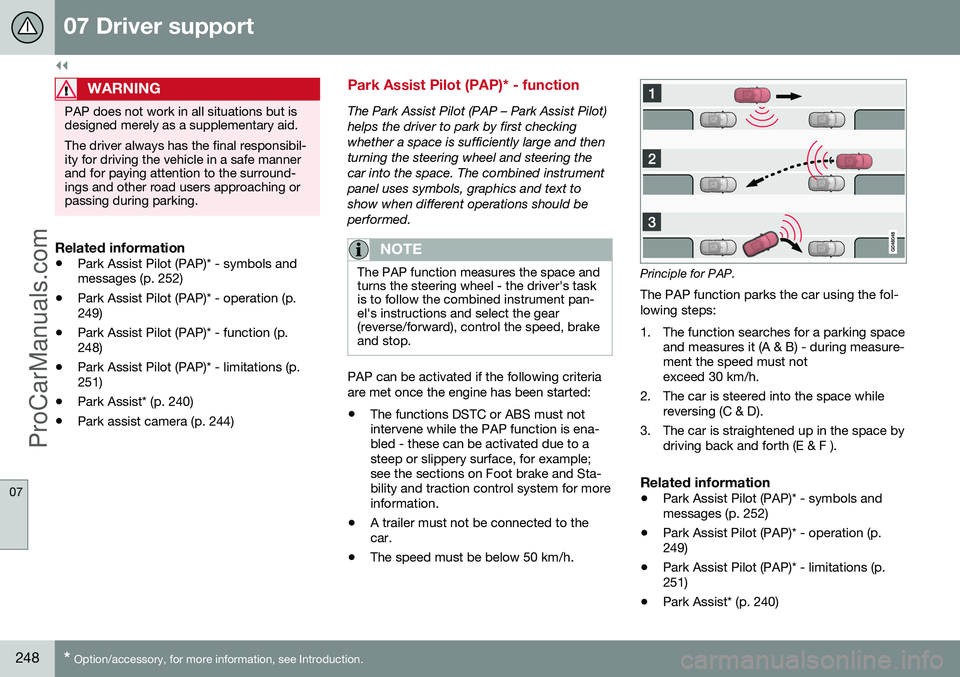
||
07 Driver support
07
248* Option/accessory, for more information, see Introduction.
WARNING
PAP does not work in all situations but is designed merely as a supplementary aid. The driver always has the final responsibil- ity for driving the vehicle in a safe mannerand for paying attention to the surround-ings and other road users approaching orpassing during parking.
Related information
• Park Assist Pilot (PAP)* - symbols and messages (p. 252)
• Park Assist Pilot (PAP)* - operation (p.249)
• Park Assist Pilot (PAP)* - function (p.248)
• Park Assist Pilot (PAP)* - limitations (p.251)
• Park Assist* (p. 240)
• Park assist camera (p. 244)
Park Assist Pilot (PAP)* - function
The Park Assist Pilot (PAP – Park Assist Pilot) helps the driver to park by first checkingwhether a space is sufficiently large and thenturning the steering wheel and steering thecar into the space. The combined instrumentpanel uses symbols, graphics and text toshow when different operations should beperformed.
NOTE
The PAP function measures the space and turns the steering wheel - the driver's taskis to follow the combined instrument pan-el's instructions and select the gear(reverse/forward), control the speed, brakeand stop.
PAP can be activated if the following criteria are met once the engine has been started:
• The functions DSTC or ABS must not intervene while the PAP function is ena-bled - these can be activated due to asteep or slippery surface, for example;see the sections on Foot brake and Sta-bility and traction control system for moreinformation.
• A trailer must not be connected to thecar.
• The speed must be below 50 km/h.
Principle for PAP.
The PAP function parks the car using the fol- lowing steps:
1. The function searches for a parking space and measures it (A & B) - during measure- ment the speed must notexceed 30 km/h.
2. The car is steered into the space while reversing (C & D).
3. The car is straightened up in the space by driving back and forth (E & F ).
Related information
• Park Assist Pilot (PAP)* - symbols andmessages (p. 252)
• Park Assist Pilot (PAP)* - operation (p.249)
• Park Assist Pilot (PAP)* - limitations (p.251)
• Park Assist* (p. 240)
ProCarManuals.co’